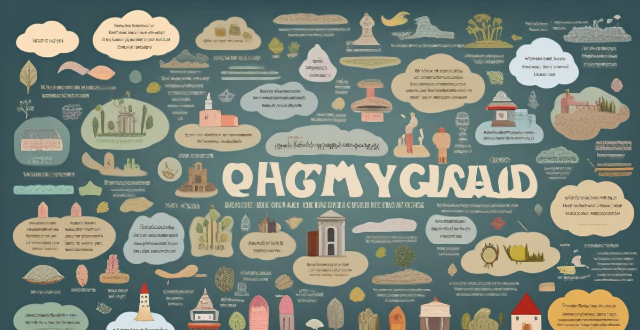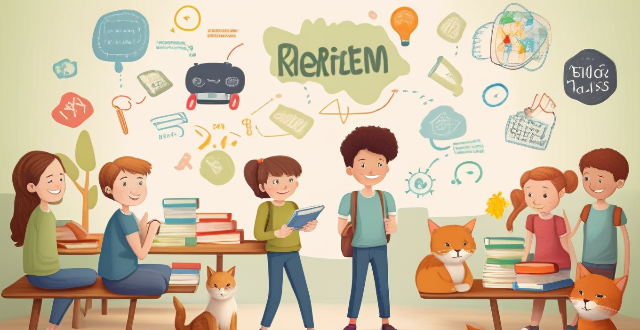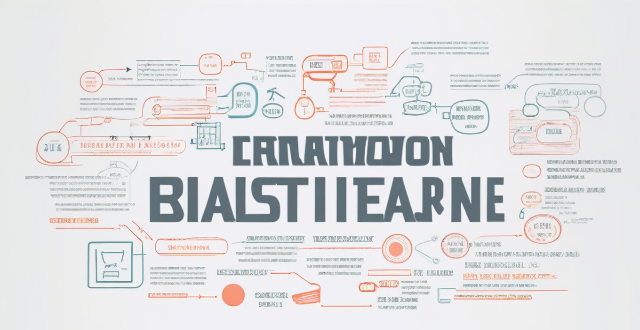Diversity Relationship

What is the relationship between biodiversity and ecosystem services ?
The text discusses the relationship between biodiversity and ecosystem services, emphasizing that biodiversity is crucial for maintaining the health and functionality of ecosystems. It highlights that diverse species contribute to ecological processes, and many ecosystem services rely on specific species or groups. High biodiversity can lead to more resilient ecosystems, while its loss can diminish these services. The text suggests that conservation efforts can enhance both biodiversity and ecosystem services, underlining the importance of recognizing and protecting this relationship for human well-being.

How does social inclusion relate to diversity and multiculturalism ?
The article discusses the relationship between social inclusion, diversity, and multiculturalism. It defines each concept and explains their importance in promoting equality, participation, and belonging. The article also highlights the benefits of diversity and multiculturalism, such as enhanced creativity and understanding among different cultural groups. The intersectionality of these concepts is explored, along with examples of inclusive policies and practices. Education is emphasized as a crucial tool for promoting social inclusion, diversity, and multiculturalism. Overall, the article concludes that these interconnected concepts are essential for building a more equitable and harmonious society.

What is the relationship between cultural fusion and social acceptance ?
The text discusses the interplay between cultural fusion and social acceptance, two significant phenomena that shape modern societies. Cultural fusion is defined as the process where different cultures interact, leading to new cultural forms, while social acceptance refers to the degree of support for diversity within a society. The text outlines key points for each concept: diversity, innovation, and interconnectedness for cultural fusion; tolerance, empathy, and equality for social acceptance. It then explores their interaction, suggesting that cultural fusion can promote social acceptance by increasing exposure to different cultures, breaking down stereotypes, and promoting tolerance. Conversely, high levels of social acceptance can foster further cultural exchange and innovation. The conclusion emphasizes the cyclical relationship between the two concepts and their importance in building harmonious societies that embrace diversity and change.

What is the relationship between biodiversity and traditional knowledge ?
The text discusses the complex interrelationship between biodiversity and traditional knowledge, highlighting how each influences and shapes the other in various ways. It explains that communities living in diverse ecosystems develop unique practices adapted to their surroundings, such as specific crop rotations or intercropping methods suited to local biodiversity. The availability of certain species also influences dietary habits, with coastal communities relying heavily on seafood while inland communities depend more on terrestrial resources. Furthermore, high biodiversity regions often lead to extensive knowledge about medicinal plants, with Indigenous communities having long histories of using local flora for healing. The need for sustainable harvesting of these plants can lead to traditional conservation practices like rotating harvest areas or planting more of certain species to ensure their survival. On the other hand, traditional knowledge often includes practices for managing resources sustainably, such as fishing techniques that do not deplete fish populations or agricultural methods that maintain soil fertility. In many cultures, certain areas are considered sacred and are protected from exploitation, serving as de facto conservation reserves. However, as biodiversity declines, so does the traditional knowledge associated with it. The loss of certain species can lead to the disappearance of associated cultural practices and knowledge. With diminished biodiversity, traditional knowledge becomes less effective, leaving communities vulnerable to ecological shifts. In conclusion, the relationship between biodiversity and traditional knowledge is one of mutual dependence and influence. While biodiversity shapes the development of traditional knowledge, this knowledge also plays a critical role in maintaining and conserving biodiversity. Preserving both is essential for the well-being of our planet and its people.

What is the connection between educational psychology and cultural diversity in the classroom ?
The text discusses the importance of integrating educational psychology and cultural diversity in classroom settings to enhance learning experiences, social skills, and academic achievement. It highlights the benefits of cultural diversity in education, including enhanced learning experiences, improved social skills, and increased academic success. The role of educational psychology is also emphasized, as it provides insights into how cultural diversity affects student learning and development. Key concepts related to cultural diversity in educational psychology include cognitive development, motivation, social interaction, and assessment. Strategies for integrating cultural diversity into educational psychology practices are also discussed, such as culturally responsive teaching, inclusive curriculum design, collaborative learning, and professional development opportunities. Overall, the text underscores the significance of addressing cultural diversity in the classroom through educational psychology principles and practices.

What role does diversity play in multicultural education ?
The text discusses the role of diversity in multicultural education, highlighting its benefits such as enhancing cultural awareness, promoting tolerance and acceptance, encouraging open-mindedness and critical thinking, and providing opportunities for personal growth and development. The author emphasizes that embracing diversity in education can contribute to creating a more inclusive and harmonious society.

How can teacher training address cultural diversity in the classroom ?
In today's globalized world, cultural diversity is an increasingly important aspect of modern classrooms. Teacher training can play a crucial role in addressing this diversity by incorporating it into curriculum design, adapting teaching methods, providing professional development opportunities, and implementing fair assessment practices. By doing so, teachers can create inclusive classrooms where all students feel valued and supported, promoting equity and enhancing learning outcomes.

What is the significance of genetic diversity within biodiversity ?
Genetic diversity is a vital component of biodiversity, playing a crucial role in ecosystem health and stability. It enables species to adapt to environmental changes, resist diseases, contribute to ecosystem functioning, support food security, and provide medicinal plants. However, threats such as habitat loss, overexploitation, climate change, introduced species, and pollution pose significant risks to genetic diversity. Conservation efforts must prioritize the protection and restoration of genetic diversity to ensure the long-term survival of species and ecosystems.

How does cultural diversity affect communication within a workplace ?
Cultural diversity has a profound impact on workplace communication, presenting both challenges and benefits. Challenges include misunderstandings due to language barriers and differences in non-verbal cues, variations in communication styles, and differing norms and expectations. Benefits encompass enhanced creativity, improved problem-solving, and greater empathy. Strategies for promoting effective communication involve education and training, clear messaging, open dialogue, and celebrating diversity. By addressing challenges and leveraging benefits, organizations can build cohesive teams that thrive on their collective differences.

What role does communication play in women's relationship management ?
The article discusses the crucial role of communication in women's relationship management, highlighting its importance in building trust, understanding, empathy, and intimacy. It also provides tips for effective communication, such as active listening, non-verbal cues, I-messages, choosing the right time and place for conversations, and compromising and collaborating. By employing these strategies, women can navigate conflicts and challenges in their relationships effectively.

What role does media play in shaping our perception of cultural diversity ?
This article explores the significant role of media in shaping our perception of cultural diversity. It highlights how media exposure to different cultures, representation of cultural diversity, and influence on attitudes and beliefs contribute to understanding and appreciation of cultural diversity. The article encourages critical thinking and active seeking out of diverse perspectives to promote a more inclusive society.

What are the impacts of climate change on tree species diversity in forests ?
Climate change significantly impacts tree species diversity in forests through altered growth and reproduction patterns, range shifts, disturbance regimes, direct physiological effects, and changes in ecosystem services. These impacts not only affect the health and structure of forests but also have broader ecological and societal implications.

How has globalization impacted cultural diversity around the world ?
Globalization has significantly impacted cultural diversity, leadingGlobalization has significantly impacted cultural diversity, leading adaptation but also potential homogen Policy and governance play a role in cultural preservation, with local resistance movements countering globalization effects. Striking a balance between global benefits and cultural preservation is crucial for maintaining diversity.

In what ways do immigration policies affect the cultural diversity of a country ?
Immigration policies play a significant role in shaping the cultural diversity of a country. Policies that promote multiculturalism, facilitate family reunification, and provide opportunities for legal migration can enhance cultural diversity. In contrast, strict immigration controls, deportation policies, and anti-immigrant sentiments can hinder it.

How can we celebrate cultural diversity through festivals and events ?
Celebrating cultural diversity is a beautiful way to foster understanding, respect, and appreciation for different cultures. Festivals and events are perfect platforms for this celebration as they bring people together in a festive atmosphere that encourages sharing and learning about diverse traditions. Here's how we can celebrate cultural diversity through festivals and events: Inclusivity in Planning and Participation: To ensure that cultural diversity is celebrated genuinely, it's essential to involve members from various cultural backgrounds in the planning and execution of festivals and events. This approach ensures that traditions are represented authentically and respectfully. Showcasing Cultural Arts and Performances: Artistic expressions like music, dance, theater, and visual arts are integral to many cultures. Featuring these during festivals allows attendees to experience the depth and beauty of different cultural art forms. Food Festivals and Culinary Experiences: Food is a universal language that transcends borders. Organizing food festivals or culinary workshops that highlight dishes from various cultures can be a delightful way to celebrate diversity. Educational Workshops and Discussion Panels: Providing opportunities for learning and dialogue enhances the understanding of different cultures. Workshops and panel discussions can cover topics like history, traditions, and contemporary issues affecting various cultural groups. Community Interaction and Networking: Festivals and events should encourage interaction among participants to build connections and foster a sense of community. These interactions can lead to lasting friendships and mutual respect among diverse groups. Respectful Representation: When celebrating cultural diversity, it's crucial to ensure that representations are respectful and avoid stereotyping or caricatures. Research and collaborate with cultural representatives to ensure accuracy and sensitivity in all aspects of the event.

How do I evaluate the cultural diversity and inclusion efforts of a school ?
Evaluating the cultural diversity and inclusion efforts of a school involves examining various aspects such as administrative policies, curriculum, student experience, community engagement, and feedback mechanisms. Key factors to consider include the presence of a clear diversity statement in policies, fair hiring and promotion practices, multicultural curriculum, teacher training, diverse student organizations, support services for diverse students, collaboration with local communities, family involvement programs, regular surveys and feedback mechanisms, and continuous improvement plans based on feedback. By assessing these elements, one can gain insight into the effectiveness of a school's efforts to promote cultural diversity and inclusion.

How can women improve their relationship management skills ?
Managing relationships is a crucial life skill that helps individuals navigate personal and professional connections effectively. For women, enhancing relationship management skills can lead to improved communication, deeper connections, and increased satisfaction in various aspects of life. The key areas to focus on include empathy and active listening, clear and honest communication, conflict resolution, boundary setting, self-awareness and personal growth, and building trust and loyalty. By practicing these skills, women can enhance their relationship management abilities and lead more fulfilling and harmonious lives.

What are the impacts of global warming on ecosystems and species diversity ?
Global warming, primarily caused by human activities, significantly impacts ecosystems and species diversity. These effects include habitat loss, altered species interactions, the spread of invasive species, disease proliferation, ocean acidification, melting permafrost, changes in fire regimes, water stress, sea level rise, coral bleaching, increased extinction risk, shifting ranges, population declines, adaptation challenges, loss of genetic diversity, behavioral changes, phenological shifts, reproductive challenges, physiological stress, and disrupted mutualisms. Addressing these issues requires immediate action to reduce greenhouse gas emissions and adapt to the changing climate.

What is the status of Kanye West and Kim Kardashian's relationship ?
Kanye West and Kim Kardashian, one of the most famous couples in Hollywood, have had a roller coaster relationship over the years. Their love story began in 2012 when they started dating, and they got married in May 2014. The couple has four children together: North, Saint, Chicago, and Psalm. Despite being one of the most talked-about couples in the world, their relationship has faced several ups and downs throughout the years. Here are some key points that highlight the status of their relationship: In the early days of their relationship, Kanye and Kim were very much in love and often shared their affection for each other on social media. They appeared to be a happy couple who were madly in love with each other. Kanye and Kim got married in a lavish ceremony in Italy in May 2014. Their wedding was a grand affair, attended by several celebrities from around the world. The couple looked very much in love during their wedding ceremony. Kim gave birth to their first child, North West, in June 2013. They welcomed their second child, Saint West, in December 2015. Their third child, Chicago West, was born via surrogacy in January 2018. Their fourth child, Psalm West, was also born via surrogacy in May 2019. Over the years, there have been several controversies surrounding their relationship. One of the most notable ones was when Kanye announced his decision to run for president in 2020. This caused a lot of tension between the couple, and Kim even considered divorce at one point. However, they managed to work through their differences and stay together. Despite facing several challenges in their relationship, Kanye and Kim have always supported each other through thick and thin. They have been there for each other during difficult times, including Kanye's mental health struggles and Kim's traumatic experience in Paris in 2016. In conclusion, Kanye West and Kim Kardashian's relationship has had its fair share of ups and downs over the years. However, they have managed to overcome all obstacles and remain a strong unit as a family. As of now, they continue to support each other and raise their beautiful children together.

How can the media be used to combat negative stereotypes and promote diversity within sports ?
The article discusses how media can be used as a tool to combat negative stereotypes and promote diversity in sports. It highlights the impact of stereotypes on sports, both positive and negative, and suggests ways for media outlets to challenge these stereotypes by showcasing diverse athletes, addressing bias and discrimination, and encouraging open dialogue about diversity. The article also provides examples of successful diversity promotion in sports media, such as increased coverage of women's sports and disability sports, and efforts to promote racial diversity within sports coverage.

How do these education policy updates address issues related to diversity and inclusion ?
Education policy updates are crucial for addressing diversity and inclusion in schools. They aim to create an equitable learning environment that caters to the needs of all students, regardless of their background or identity. These updates contribute to promoting diversity and inclusion by recognizing and valuing diverse perspectives, providing access to education for all students, promoting cultural competency among educators, encouraging inclusive curriculum design, addressing bias and stereotyping, and supporting special education needs. By implementing these policies, schools can create a more equitable and inclusive learning environment that benefits all students, regardless of their background or identity.

What is the relationship between heat waves and mortality rates ?
The text discusses the relationship between heat waves and mortality rates, highlighting various factors that contribute to this complex relationship. It emphasizes the increased risk of heat-related illnesses like dehydration, heat exhaustion, and heat stroke during heat waves, which can lead to serious complications and death if not treated properly. The article also notes the impact of heat waves on chronic health conditions like cardiovascular disease, respiratory problems, and diabetes. Age-related vulnerabilities are discussed, with older adults being particularly susceptible due to physiological changes and a higher prevalence of chronic health conditions. Socioeconomic factors are identified as crucial determinants of an individual's vulnerability to the adverse effects of heat waves, including housing quality, healthcare access, education level, and employment status. The text concludes by stressing the importance of public health strategies aimed at reducing the impact of heat waves on vulnerable populations.

How can I build a strong relationship with my investors ?
The article emphasizes the importance of building a strong relationship with investors for the success of a business. It outlines several key strategies to achieve this, including communication, trustworthiness, collaboration, recognition, professionalism, and continuous improvement. The tips provided suggest that regular updates, transparency, active listening, fulfilling promises, integrity, partnership approach, joint decision making, appreciation, acknowledgement of success, punctuality, high-quality presentation materials, seeking learning opportunities, and creating a feedback loop are all crucial elements in fostering a positive relationship with investors. By following these guidelines, businesses can establish a strong foundation of trust, transparency, and collaboration that will lead to mutually beneficial relationships and ultimately contribute to the success of their ventures.

What is the relationship between economic recovery and employment rates ?
The relationship between economic recovery and employment rates is influenced by various factors such as increased aggregate demand, investment in the economy, government policies, and global factors. As the economy recovers, businesses start hiring more workers to meet the growing demand for goods and services, leading to an increase in employment rates. However, this relationship is complex and requires a deeper understanding of the different aspects involved.

What is the relationship between ESG and corporate governance ?
The article explores the relationship between Environmental, SocialThe article explores the relationship between Environmental, Social (ESG) factors and It states that ESG is often considered a subset of corporate governance and focuses on specific aspects of how a company operates. Companies that prioritize ESG factors tend to have stronger corporate governance structures in place. The role of boards in overseeing a company's ESG initiatives is also discussed. Regulations and stakeholder pressure are driving the need for effective corporate governance. Best practices for integrating ESG into corporate governance include defining clear objectives, regular reviews, stakeholder engagement, and maintaining transparency and accountability.

How does cultural diversity affect international cooperation ?
Cultural diversity significantly impacts international cooperation by influencing communication, ethical perspectives, decision-making approaches, business practices, legal and governmental systems, and social norms. Understanding these differences is crucial for fostering successful global partnerships.

What is the relationship between social harmony and mental health ?
The text discusses the relationship between social harmony and mental health. Social harmony refers to a state of peaceful coexistence among individuals, groups, or communities where there is mutual respect, cooperation, and understanding. Mental health pertains to a person's emotional, psychological, and social well-being. The impact of social harmony on mental health includes promoting emotional security, encouraging positive interactions, and enhancing social support networks. The impact of mental health on social harmony includes contributing to positive interactions, promoting empathy and understanding, and reducing conflict and tension. The conclusion states that the relationship between social harmony and mental health is bidirectional and that efforts to improve one will inherently benefit the other.

What is the relationship between groundwater depletion and sea-level rise ?
Groundwater depletion and sea-level rise are interconnected environmental issues that share a relationship with climate change. Both phenomena have significant implications for global ecosystems and human societies, including reduced water availability, coastal flooding, saltwater intrusion, and habitat loss. The connection between groundwater depletion and sea-level rise lies primarily in their shared relationship with climate change and its effects on hydrological cycles. Addressing these challenges together within a broader context of climate change adaptation and sustainable resource management is crucial for developing effective strategies to mitigate their impacts on our environment and society.

What is the importance of building a strong parent-teacher relationship in supporting student learning ?
The Importance of Building a Strong Parent-Teacher Relationship in Supporting Student Learning Building a strong parent-teacher relationship is crucial for supporting student learning. This partnership between parents and teachers can have a significant impact on a child's academic success, social development, and overall well-being. A strong parent-teacher relationship fosters open and effective communication channels, creates a supportive learning environment, promotes shared responsibility for a student's education, and cultivates positive attitudes toward education. By working together, parents and teachers can help students reach their full potential and prepare them for success in all aspects of life.

How do paparazzi influence the spread of celebrity relationship rumors ?
Paparazzi significantly shape public perception of celebrity relationships by constantly surveilling celebrities, using invasive tactics, and promoting sensationalism over facts. They collaborate with tabloids and utilize social media to instantly disseminate information, leading to rapid rumor spreading. This relentless pursuit affects celebrities' privacy and emotional well-being, raising concerns about media ethics and privacy rights.